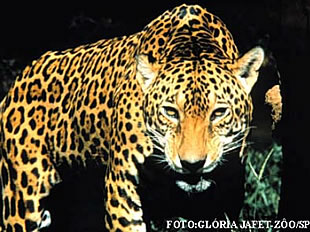Most hunting is done at night on ground. Jaguars either stalk or ambush
their prey. Due to their build of muscle, Jaguars are able to drag dead
carcasses 3-4 times its own body weight distances up to a kilometer in order
to get it to a sheltered spot. Depending on availability, its food source
consists of: armadillos, pacas, capybaras, deer, peccaries, tamanduas,
coatis, turtles, iguanas, some birds, and even fish. Small prey are killed
by a smack of the forepaw, while large prey are killed with bites on the
neck or head which crush the spinal cord or break the skull. Although
Jaguars tend to be solitary, adults sometimes will travel and hunt in pairs,
usually breeding pairs, but sometimes two male and two females.
(Field Guide to the Mammals of Central America and Southeast Mexico)
(Walker's Mammals of the World)
